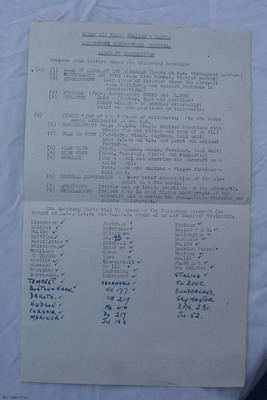Aircraft recognition lesson
Title
Aircraft recognition lesson
Description
Instructions for preparation of an aircraft recognition lecture to the air gunners instructors course. Lists the aircraft to be covered.
This item was sent to the IBCC Digital Archive already in digital form. No better quality copies are available.
This item was sent to the IBCC Digital Archive already in digital form. No better quality copies are available.
Language
Format
One page typewritten document with handwritten annotation
Publisher
Rights
This content is available under a CC BY-NC 4.0 International license (Creative Commons Attribution-NonCommercial 4.0). It has been published ‘as is’ and may contain inaccuracies or culturally inappropriate references that do not necessarily reflect the official policy or position of the University of Lincoln or the International Bomber Command Centre. For more information, visit https://creativecommons.org/licenses/by-nc/4.0/ and https://ibccdigitalarchive.lincoln.ac.uk/omeka/legal.
Contributor
Identifier
SWeirG19660703v060004-0002
Transcription
[underlined] ROYAL AIR FORCE STATION – MANBY. [/underlined]
[underlined] AIR GUNNER INSTRUCTORS COURSES. [/underlined]
[underlined] AIRCRAFT RECOGNITION [/underlined]
Prepare your lecture under the following headings:
(A) (1) NAME OF AIRCRAFT AND WINGSPAN (Leave on b.b. throughout lecture)
(2) NATIONALITY AND TYPE (e.g. Dive bomber, Fighter bomber)
(3) DEVELOPMENT (Any items of interest about the aircraft e.g. designer, and special features in construction.)
(4) ENGINES (Type, horsepower) SPEED and RANGE
(5) ARMAMENT GUNS – (Number, type and position)
BOMBS ─ (Load – if carried externally)
Point out gun positions on silhouette.
(B) DESCRIPTION of the 3 views of silhouette. Pin the large scale silhouette on the b.b.
(1) CONSTRUCTION (e.g. FW.190. Single Engined Monoplane with Single fin and rudder and span of 34 ft.)
(2) HEAD ON VIEW (Fuselage, wings, engines, tail unit) Draw H.O.V. on b.b. and point out salient features.
(3) PLAN VIEW (Nose, engines, wings, fuselage, tail unit)
(4) SIDE VIEW (Nose, fuselage, fin(s) and rudder(s))
(5) SUMMARY (Use a model and describe the aircraft as a solid body).
Name, nose and engines – wings – fuselage – tail unit.
(6) GENERAL IMPRESSION (A very brief description of the aircraft in a few words.)
(7) QUESTIONS (Either ask or invite questions on the aircraft).
(8) EPIDIASCOPE (Select 5 to 10 good flying photographs of the aircraft and describe the recognition features and p[missing letter/word] points of interest.)
The spotting Tests will be based on the following aircraft (as taught at A.G., I.T.W. and E.A.G.S. stage of an Air Gunners’ Training).
Liberator [symbol] ─ Fortress [symbol] ─ Typhoon [symbol]
Halifax [symbol] ─ Hurricane [symbol] ─ Me.109 F & G. [symbol]
FW.190 [symbol] ─ Kittyhawk ─ Wellington [symbol]
Spitfire [symbol] ─ Ju.87D [symbol] ─ Marauder [symbol]
Beaufighter [symbol] ─ Mitchell [symbol] ─ FW.189 [symbol]
Baltimore, [symbol] ─ Beaufort [symbol] ─ Hadrian (Waco) [symbol]
Hamilcar ─ Horsa [symbol] ─ Mustang [symbol]
JU 90/290 [symbol] ─ York [symbol] ─ Me.110 [symbol]
Martlet [symbol] ─ Thunderbolt [symbol] ─ Ju.88 A 6 [symbol]
Warwick [symbol] ─ He111 [symbol] ─ Go. 242/244 [symbol]
Mosquito [symbol] ─ Lightning [symbol]
Borracuda.[sic] [symbol] ─ Lancaster [symbol] ─ Stirling [symbol]
TEMPEST. [symbol] ─ ABERMARLE [sic] [symbol] ─ FW 200C.
BOSTON & HAVOC. [symbol] ─ HE 177. [symbol] ─ SUNDERLAND.
DAKOTA. [symbol] ─ HE 219 ─ SKY MASTER.
HUDSON [symbol] ─ ME 410 ─ D.F.S. 230.
CORSAIR. [symbol] ─ DO 217 ─ JU 52.
MARINER [symbol] ─ JU 188
[underlined] AIR GUNNER INSTRUCTORS COURSES. [/underlined]
[underlined] AIRCRAFT RECOGNITION [/underlined]
Prepare your lecture under the following headings:
(A) (1) NAME OF AIRCRAFT AND WINGSPAN (Leave on b.b. throughout lecture)
(2) NATIONALITY AND TYPE (e.g. Dive bomber, Fighter bomber)
(3) DEVELOPMENT (Any items of interest about the aircraft e.g. designer, and special features in construction.)
(4) ENGINES (Type, horsepower) SPEED and RANGE
(5) ARMAMENT GUNS – (Number, type and position)
BOMBS ─ (Load – if carried externally)
Point out gun positions on silhouette.
(B) DESCRIPTION of the 3 views of silhouette. Pin the large scale silhouette on the b.b.
(1) CONSTRUCTION (e.g. FW.190. Single Engined Monoplane with Single fin and rudder and span of 34 ft.)
(2) HEAD ON VIEW (Fuselage, wings, engines, tail unit) Draw H.O.V. on b.b. and point out salient features.
(3) PLAN VIEW (Nose, engines, wings, fuselage, tail unit)
(4) SIDE VIEW (Nose, fuselage, fin(s) and rudder(s))
(5) SUMMARY (Use a model and describe the aircraft as a solid body).
Name, nose and engines – wings – fuselage – tail unit.
(6) GENERAL IMPRESSION (A very brief description of the aircraft in a few words.)
(7) QUESTIONS (Either ask or invite questions on the aircraft).
(8) EPIDIASCOPE (Select 5 to 10 good flying photographs of the aircraft and describe the recognition features and p[missing letter/word] points of interest.)
The spotting Tests will be based on the following aircraft (as taught at A.G., I.T.W. and E.A.G.S. stage of an Air Gunners’ Training).
Liberator [symbol] ─ Fortress [symbol] ─ Typhoon [symbol]
Halifax [symbol] ─ Hurricane [symbol] ─ Me.109 F & G. [symbol]
FW.190 [symbol] ─ Kittyhawk ─ Wellington [symbol]
Spitfire [symbol] ─ Ju.87D [symbol] ─ Marauder [symbol]
Beaufighter [symbol] ─ Mitchell [symbol] ─ FW.189 [symbol]
Baltimore, [symbol] ─ Beaufort [symbol] ─ Hadrian (Waco) [symbol]
Hamilcar ─ Horsa [symbol] ─ Mustang [symbol]
JU 90/290 [symbol] ─ York [symbol] ─ Me.110 [symbol]
Martlet [symbol] ─ Thunderbolt [symbol] ─ Ju.88 A 6 [symbol]
Warwick [symbol] ─ He111 [symbol] ─ Go. 242/244 [symbol]
Mosquito [symbol] ─ Lightning [symbol]
Borracuda.[sic] [symbol] ─ Lancaster [symbol] ─ Stirling [symbol]
TEMPEST. [symbol] ─ ABERMARLE [sic] [symbol] ─ FW 200C.
BOSTON & HAVOC. [symbol] ─ HE 177. [symbol] ─ SUNDERLAND.
DAKOTA. [symbol] ─ HE 219 ─ SKY MASTER.
HUDSON [symbol] ─ ME 410 ─ D.F.S. 230.
CORSAIR. [symbol] ─ DO 217 ─ JU 52.
MARINER [symbol] ─ JU 188
Collection
Citation
“Aircraft recognition lesson,” IBCC Digital Archive, accessed July 26, 2024, https://ibccdigitalarchive.lincoln.ac.uk/omeka/collections/document/34484.
Item Relations
This item has no relations.

